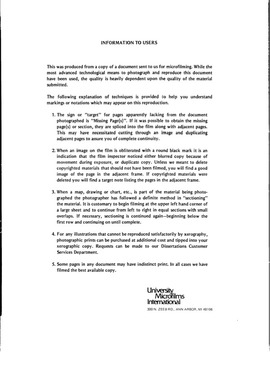| dc.contributor.author | Doolittle, Graydon H., | en_US |
| dc.date.accessioned | 2013-08-16T12:28:31Z | |
| dc.date.available | 2013-08-16T12:28:31Z | |
| dc.date.issued | 1982 | en_US |
| dc.identifier.uri | https://hdl.handle.net/11244/4971 | |
| dc.description.abstract | Prior research has shown that schools serve to foster a national cultural identity in those who attend. In this sense, they function to pass on or conserve the values of the dominant culture. Schools also function to promote social change. In this investigation it is demonstrated that these two functions conflict with respect to American Indians and promote behaviors which are opposite from those intended. Conflict in cognitive style and accommodation to an acculturative situation produce Indian student adaptive strategies which are different from those of other students. | en_US |
| dc.description.abstract | This study is concerned with the sources of behavior of Indian students in two public elementary schools. Since public education has dramatically failed to educate Indian children, this study was undertaken to isolate those mechanisms which produce behavior in Indian children that lead to this failure. | en_US |
| dc.description.abstract | Lack of control by Indian parents over the education of their children is a major factor in the conflict of cognitive style and acculturative experiences. This lack of control is contributed to in part by those very behaviors generated in schools. The conflict between the culture-conserving and change-promoting functions of schools as regards ethnic minority students is a field in serious need of careful investigation. | en_US |
| dc.description.abstract | This research included a year of ethnographic study of two Oklahoma elementary schools with large Indian minorities--Carnegie, located in the former Kiowa-Comanche-Apache-Wichita reservation, and Wewoka, in the old Seminole Nation. The study finds that differences in the behavior of Indian children are explained by differences in tribal and community histories and school organizational differences. The ethnographic data reveal that both groups of Indian students share strikingly similar responses to the institutional conditions found in schools. | en_US |
| dc.format.extent | iv, 257 leaves : | en_US |
| dc.subject | Anthropology, Cultural. | en_US |
| dc.title | Indian students in public schools : | en_US |
| dc.type | Thesis | en_US |
| dc.thesis.degree | Ph.D. | en_US |
| dc.thesis.degreeDiscipline | Department of Anthropology | en_US |
| dc.note | Source: Dissertation Abstracts International, Volume: 43-02, Section: A, page: 0492. | en_US |
| ou.identifier | (UMI)AAI8215905 | en_US |
| ou.group | College of Arts and Sciences::Department of Anthropology | |
